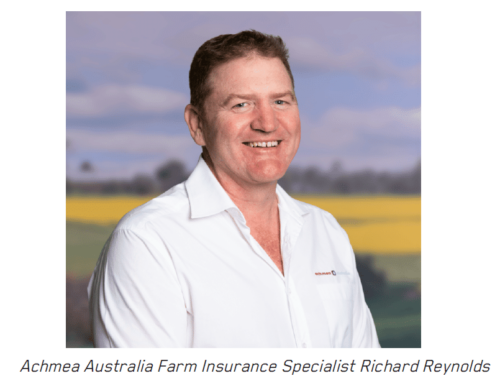
As a cattle farmer, selecting a bull is often one of the most important decisions you make for the profitability of your beef operation, says Achmea Australia Farm Insurance Specialist Richard Reynolds.
Raised on his family cattle property, Richard currently runs a Beef Stud Cattle operation with his family at Gin Gin in Queensland.
Richard says a bull is your investment in the future of your herd and beef operation.
“The bull you choose today will directly influence the genetics of your herd for the next 10 to 15 years. With such a significant impact on the future productivity of your herd, it is important to choose wisely,” said Richard.
“Therefore, before heading to the saleyards, I encourage buyers to have a good understanding of their beef operations and their breeding objectives, in terms of what will boost their herd performance. This is a critical part of selecting a bull,” Richard said.
Richard offers buyers these important tips for choosing a bull:
- Understand your breeding objectives and recognise the key traits you are looking to increase in your herd to achieve these objectives.
- Research the breeder. They may produce the breed you are looking for; but check whether they also manage and produce animals that will thrive in the environment and management practices on your farm.
- Use breeding tools available, such as Estimated Breeding Values (EBVs). EBVs are genetic evaluation systems used to assess several important production traits and provide an indication (estimate) of how an animal’s offspring will perform.
- Conduct a visual inspection. Structural soundness is a vital factor in the bull’s fertility and routine examination is recommended. Visual examination combined with the use of EBVs will provide a balanced evaluation of his structure and temperament.
- Obtain a Veterinary Bull Breeding Soundness Evaluation (VBBSE), which is a test designed to identify structural issues that will impact the bull’s health and ability to be productive. This includes a semen motility test which shows the probability of being fertile by evaluating the live sperm count.
- Consider undertaking a semen morphology test, which is recommended as it tests the quality of sperm and can identify possible fertility issues.
Once buyers have selected their bull, a critical part of risk management is adequate stud stock insurance to cover loss of use. This can occur from accidental causes, sickness, disease, mortality or transporting the bull home from the sale.
“A bull owner must consider what level of risk they are comfortable with, that is whether they opt to insure against mortality alone or whether they also want cover for accidental loss of use, sickness or disease,” Richard said.
“If unsure, we always encourage buyers to speak with their insurer directly to better understand exactly what is included in the policy,” he said.
“We encourage buyers to check that their insurance includes transit cover, as ownership of the bull transfers to the buyer from the fall of the hammer,” said Richard.
Insurance issued by Achmea Schadeverzekeringen N.V. (Achmea)
ABN 86 158 237 702 AFSL 433984.
The information in this document is general advice only and does not take into account your individual objectives, financial situation or needs (your personal circumstances). The information in this advertisement or article is general advice only and does not take into account your individual objectives, financial situation or needs (your personal circumstances). Before using this information to decide whether to purchase the insurance policy, you should consider your personal circumstances and the relevant Policy Wording available from the ‘Downloads’ section of our website www.achmea.com.au Achmea Australia does not warrant that the information contained herein is accurate, reliable, complete or up to date, and, to the fullest extent permitted by law, disclaims all liability of Achmea Australia and its Associates for any loss or damage suffered by any person by reason of the use by that person of, or their reliance on, any information contained in this document or any error or defect in on this document, whether arising from the negligence of Achmea Australia or its Associates or otherwise.

